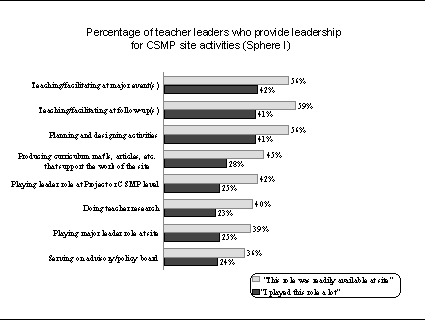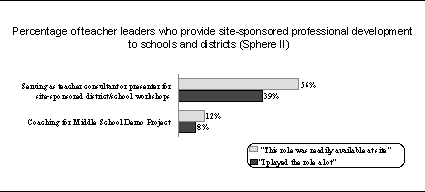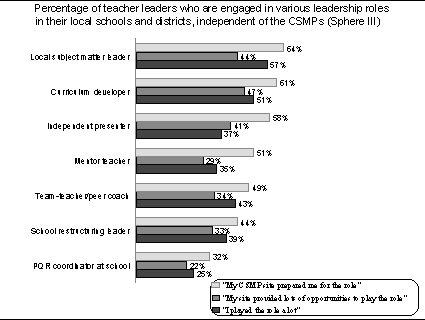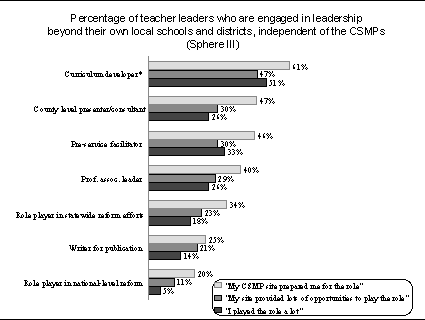|
author:
|
Inverness Research Associates
|
|
submitter:
|
Mark St. John
|
|
description:
|
This is one of three reports (Including The
Contributions of Teacher Leaders and The Work of
Teacher Leaders) wrriten by Inverness Associates
on the California Subject Matter Projects (CSMP).
"The CSMPs consist of nine Projects providing
professional development in nine different
disciplines...at 101 regional sites--all of which are
designed to attract, develop, nurture, sustain, and
promote teacher leadership."
This report examines the scale and nature of CSMP teacher leadership statewide and assesses the work of individual sites in determining the degree that they were successful in developing and deploying teacher leaders.
|
|
published in:
|
Inverness Research Associates
|
|
published:
|
1999
|
|
posted to site:
|
01/14/1999
|
4) What specific leadership activities are CSMP teacher leaders engaged in?
When we look at specific leadership activities that CSMP teacher leaders are engaged in, we find that more teacher leaders are significantly involved in the following activities than in any others:
- serving as a local school or department subject matter leader/specialist; for example, as a district curriculum committee member, school discipline expert or department chair (57 percent of the teacher leaders play these key roles);
- developing curriculum (51 percent);
- planning and designing site activities (41 percent);
- teaching or facilitating at institutes (41 percent);
- teaching or facilitating at follow-ups and other major events (41 percent);
- serving as a teacher consultant or presenter for site-sponsored workshops for schools and districts (39 percent);
- independently presenting at other school(s) or district(s) (37 percent).
Teacher leaders are performing these and many other key leadership roles at each venue available to them.
Leadership at CSMP sites (Sphere I)
A significant minority of the teacher leaders we surveyed are actively engaged in the work of the site. Many, but by no means all, of the teacher leaders report that there are many different leadership roles at the site that are "open to them."
- Twenty-five percent of the survey sample were very active in central leadership roles at the site such as being co-director or board member during the previous year. Another 15 percent thought that such roles were readily available to them, even if they elected not to pursue them.
- About 40 percent of the teacher leaders shared their expertise with teacher colleagues at their CSMP sites. They planned and designed activities and/or taught or facilitated at institutes and/or follow-ups. Another 20 percent said that they could have played such roles if they wanted to.
- About a quarter contributed to the collective knowledge of the site by creating curriculum or other materials and/or engaging in teacher research.

Percentages represent teachers who say that the role was "readily available at the site" and that they "played the role a lot" in the last 12 months. In a related question, those who played each role were asked whether their site provided enough support for them to feel successful. On average about 80 percent said that their sites provided sufficient support.
Site-sponsored professional development to schools and districts (Sphere II)
CSMP sites "deploy" teacher leaders to provide professional development to schools and districts in response to specific needs and interests of their region. This strategy is beneficial to all parties. Exemplary teachers get the satisfaction of sharing their classroom practices; sites generate income and "reach" far more teachers than they could otherwise; and the teachers they serve value the fact that teacher leaders are "in the trenches" themselves.
- About 40 percent of the teacher leader sample provide professional development to local schools and districts under sponsorship of their CSMP site. A small percentage of the sample are sponsored as mathematics coaches for the state’s Middle School Demonstration Program.

Percentages represent teachers who say that the role was "readily available at the site" and that they "played the role a lot" in the last 12 months. In a related question, those who played each role were asked whether their site provided enough support for them to feel successful. Seventy-seven percent said that their sites provided as much support as they needed for teacher consultant work; half of the Middle School Demonstration coaches who responded felt adequately supported.
Independent leadership (Sphere III)
One measure of the value of the CSMPs is the degree to which teacher leaders are independently performing in other leadership roles and contributing back to their local schools. The majority of teacher leaders who responded to the survey are, in fact, leaders of local efforts to improve their own schools and up to a third appear to be working in broader venues.
- About 60 percent have worked extensively as local school or department subject matter leaders and specialists (on district curriculum committees, school discipline experts or department chairs).

Percentages represent teachers who say that they have been prepared by their CSMP site to play a role, that the site helped provide them opportunities to play the role, and that they have played the role to a great extent in the last 12 months (i.e. give a rating of 3 on a 3-point scale where 1 = "not at all" and 3 = "a lot").
- In the 12 months prior to their completing the survey, a quarter to a third of these teachers were active as pre-service facilitators (33 percent), county level presenters and consultants (26 percent), and leaders in professional associations (26 percent).
- Nearly one in five (18 percent) was active in statewide curriculum reform efforts and almost as many (14 percent) wrote for publication.
- One in twenty (five percent) were significantly involved in national-level reform activities.

Percentages represent teachers who say that they have been prepared by their CSMP site to play a role, that the site helped provide them opportunities to play the role, and that they have played the role to a great extent in the last 12 months (i.e. give a rating of 3 on a 3-point scale where 1 = "not at all" and 3 = "a lot").
How much time do teacher leaders devote to leadership activities?
The typical teacher leader estimates that she or he spends about 12 days a year in site-sponsored leadership activities and 15 days in other leadership roles.
- That is the equivalent of a full month’s contribution each year by the typical teacher leader to his or her profession and discipline.
How many other teachers do the teacher leaders work with?
The typical teacher leader works closely in an informal or formal leadership capacity with 10 to 15 other teachers in each venue — CSMP site, own school, own district, and other districts — in which she or he is active as a leader.
It is not possible to determine with any certainty the number of individual teachers influenced by CSMP teacher leaders. However, the following estimates at least provide "ballpark" figures for discussion and refinement:
- We estimate that the teacher leaders who responded to the survey worked with perhaps 35,000 to 70,000 other teachers during a one-year period.21 This is equal to about 15 to 30 percent of the state’s teachers.
- Based on teacher leaders’ estimates of the number of teachers that they have worked with closely in an informal or formal leadership capacity, it appears that a fifth (20 percent) of the teachers they work with attend site activities and the rest interact with the teacher leaders in the teacher leaders’ own schools (12 percent), in other schools in their districts (31 percent) and in other districts (37 percent).
How much do teacher leaders earn in stipends for their leadership work?
Teacher leader stipends are exceedingly modest, given the level of teacher leader activity in each sphere.
- The typical teacher leader earns only $40 dollars a day, or $500 total, for his or her site-sponsored leadership (Spheres I and II).
- The typical teacher leader receives only $100 a year in stipends. The rare teacher leader earns up to $10,000 a year for his or her other leadership activities in schools and districts (Sphere III).
|

